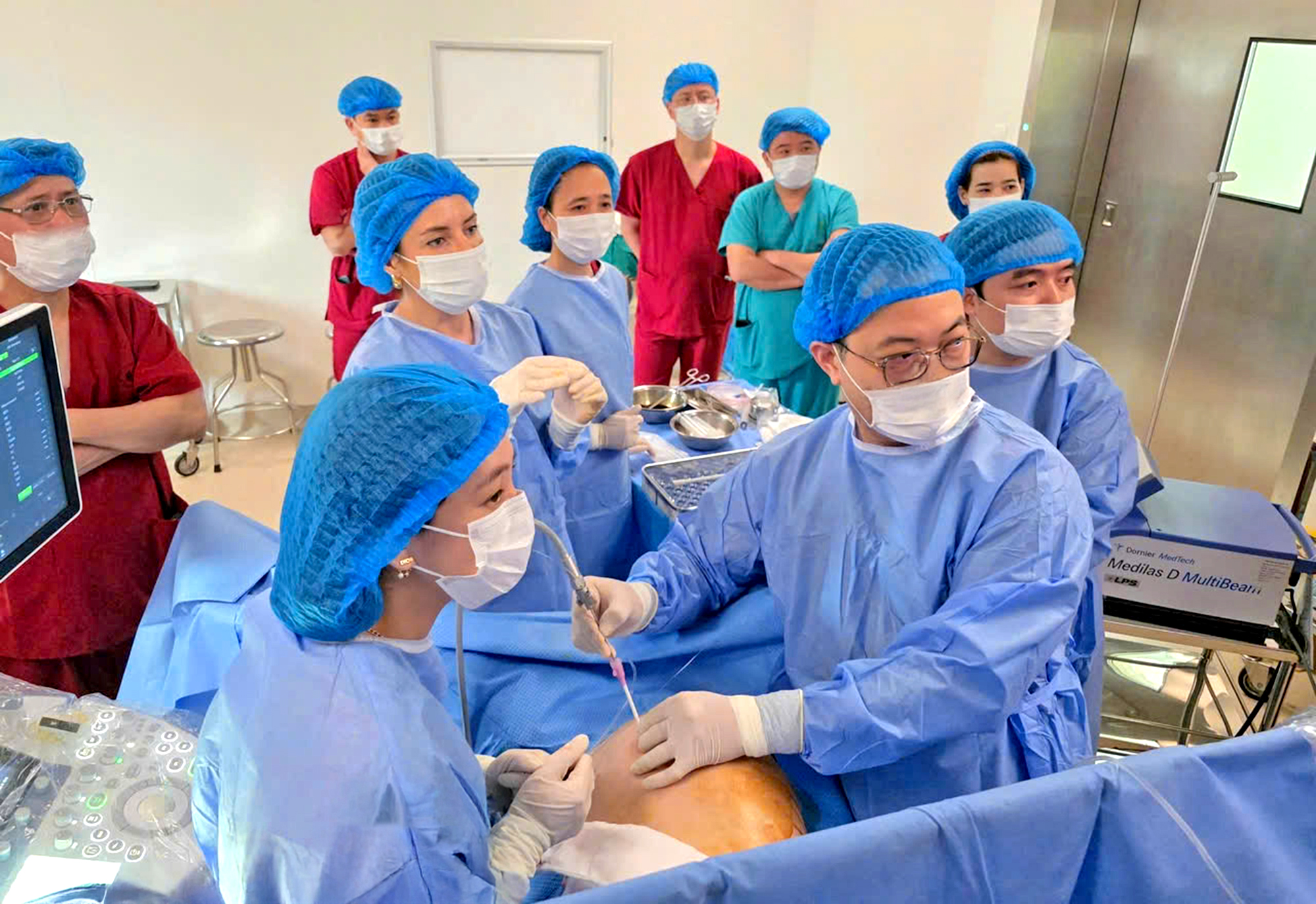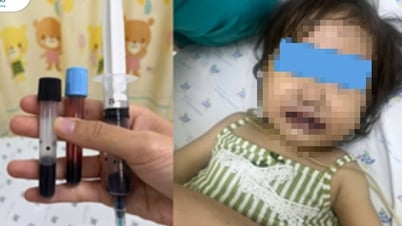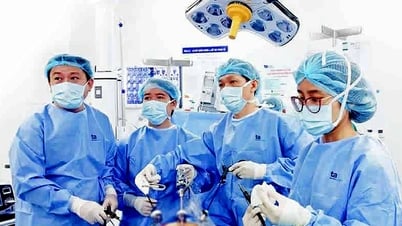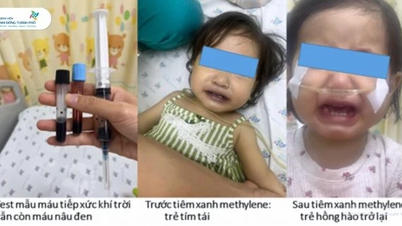First direct intervention
Ms. DTP was pregnant through IVF (in vitro fertilization), had a history of uterine fibroids, and prenatal screening detected fetal abnormalities from the 16th week of pregnancy.

A pleural effusion aspiration intervention for the fetus was recently performed at Hanoi Obstetrics Hospital.
When she came to the Fetal Intervention Center - Hanoi Obstetrics and Gynecology Hospital for examination, the ultrasound results showed that the fetus had a large amount of bilateral pleural effusion, causing passive lung collapse. In addition, the peritoneum had little fluid under the liver capsule, the small intestine had increased echoes, and the uterine wall had many large fibroids, increasing the risk of complications during pregnancy.
Pleural effusion can seriously affect the development and respiratory ability of the fetus after birth. Accordingly, the team of doctors performed an endoscopy to drain the fluid for the fetus right in the mother's womb. After the procedure, the fetus's lungs expanded, the fetus's condition initially stabilized and continued to be closely monitored.
Dr. Do Tuan Dat, Head of the Department of Obstetrics and Gynecology, Hanoi Obstetrics and Gynecology Hospital, shared that he and his colleagues have participated in fetal intervention for several hundred cases since the end of 2022. However, this is the first case where the team directly intervened on the fetus' body.
"The intervention is divided into two phases. The first phase is pain relief and anesthesia for the fetus, and the second phase is lung aspiration. Initially, it was planned to puncture both lungs, but when the aspiration was successful on one side, the other side almost decreased, so only one side needed to be punctured," said Dr. Dat.
High technical requirements
According to Dr. Dat, fetal intervention requires doctors to have a lot of knowledge about internal medicine, to be able to predict pathological changes in the mother and baby before and during the intervention.
Many babies with congenital malformations were treated in the womb, were born, and were successfully treated. Later, the family brought the baby back to the hospital to meet the doctor, which was the greatest thank you we received.
Dr. Dinh Thuy Linh
Sharing more about the fetal lung fluid aspiration, Dr. Dat said: "When performing this surgery, the doctor must be sure of the ultrasound because it is not like a normal surgery, where you open everything up to see with the naked eye. Surgery through ultrasound requires imagining where the needle goes. The doctor must insert the needle through the mother's abdominal wall, the chorionic membrane, the uterus, and the baby's chest wall to get the fluid. Moreover, the baby in the amniotic sac is mobile and floating, so it is not fixed to facilitate the surgery.
The team worked and listened to both the mother and the baby. The luckiest thing was that this time, they had the support and guidance of a leading Italian professor of fetal medicine, which helped the team feel more confident when performing the new technique."
According to Dr. Dat, before the fetal intervention technique was implemented at Hanoi Obstetrics Hospital, in many cases of twin-to-twin transfusion syndrome, doctors had to helplessly watch the fetus die. Now the success rate of keeping the fetus is very high.
The same goes for cases of oligohydramnios, amniotic fluid transfusion helps the baby to prolong its development time in the uterus, until full term birth, which is extremely important for the baby.
Prenatal screening and diagnosis are very important.
Sharing about prenatal diagnosis for fetuses, Dr. Dinh Thuy Linh, Director of the Center for Prenatal and Newborn Screening and Diagnosis, said that fetuses can have many abnormalities in morphology: cardiovascular, central nervous system, digestive, urinary, maxillofacial, bone, limb, brittle bone, abnormal limb posture, crooked limbs... Or congenital abnormalities due to Down syndrome, single-gene genetic diseases, muscular dystrophy...
Dr. Linh emphasized that congenital abnormalities are screened and diagnosed prenatally, which is very valuable, and from there, a monitoring strategy can be developed. Babies found to have abnormalities will have a plan for fetal monitoring, and care right from the golden hour after birth, increasing the survival rate and successful treatment.
According to Dr. Linh, each month, at Hanoi Obstetrics and Gynecology Hospital, there are about 400-500 fetuses with congenital abnormalities that need to be examined and monitored. There are congenital abnormalities detected early before birth that can be treated in the fetus, but there are also cases that can only be treated after the baby is born.
Source: https://www.baogiaothong.vn/giai-cuu-thai-nhi-ngay-tu-trong-bung-me-192250313233405941.htm





![[Photo] Prime Minister Pham Minh Chinh chairs the national online conference on combating smuggling, production and trade of counterfeit goods.](https://vphoto.vietnam.vn/thumb/1200x675/vietnam/resource/IMAGE/2025/6/23/4a682a11bb5c47d5ba84d8c5037df029)






















![[Photo] Prime Minister Pham Minh Chinh holds meeting to launch exhibition of national achievements to celebrate 80th National Day](https://vphoto.vietnam.vn/thumb/1200x675/vietnam/resource/IMAGE/2025/6/23/0c0c37481bc64a9ab31b887dcff81e40)










































![[Infographic] The 1st Congress of the Party Committee of the Ministry of Culture, Sports and Tourism, term 2025-2030](https://vphoto.vietnam.vn/thumb/402x226/vietnam/resource/IMAGE/2025/6/24/8afbd7c780424568b23fd09cd74c8b1d)




























Comment (0)